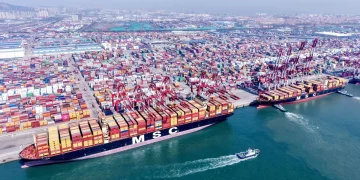Introduction
The global market landscape has always been susceptible to shifts caused by a variety of factors, including economic cycles, technological advancements, and political changes. However, in recent years, two major forces have significantly reshaped international markets: global pandemics and geopolitical tensions. The COVID-19 pandemic, the most significant global health crisis of the 21st century, and ongoing geopolitical tensions such as trade wars, regional conflicts, and shifting alliances have created new economic realities. These forces have altered everything from trade flows and supply chains to investor sentiment and capital markets, influencing long-term global economic trends. This article will explore how the COVID-19 pandemic and geopolitical issues are reshaping international market dynamics and the implications of these changes for businesses, investors, and policymakers.
Section 1: The Impact of the COVID-19 Pandemic on Global Markets
The COVID-19 pandemic has had a profound and lasting effect on international markets. While its initial impact was highly disruptive, the long-term changes it triggered are reshaping the global economy in ways that may persist for years to come.
Economic Disruption and Market Volatility
The onset of the COVID-19 pandemic in early 2020 led to widespread lockdowns, factory closures, disruptions to global supply chains, and sharp declines in consumer demand. In response, governments worldwide implemented unprecedented fiscal and monetary policies to stabilize their economies. These included stimulus packages, interest rate cuts, and direct financial support to businesses and individuals.
Key Impacts on Global Markets:
- Stock Market Volatility: The early months of the pandemic saw global stock markets plummet due to investor panic. However, after central banks’ aggressive monetary interventions, many markets rebounded sharply. Stock indices, particularly in the U.S. and China, quickly recovered and reached new highs, spurred by the economic stimulus measures and growing optimism about vaccine development.
- Commodity Prices: Commodity markets were hit hard initially. Oil prices, for example, collapsed to historic lows during the height of the pandemic, as demand for energy plummeted. However, as economies began to reopen, oil prices rebounded, with geopolitical tensions in the Middle East and supply chain bottlenecks adding to volatility in the commodity markets.
- Interest Rates and Bond Markets: Central banks slashed interest rates to historically low levels to support economic recovery. This environment of low interest rates led to a shift in investor behavior, with more capital flowing into stocks and riskier assets while reducing demand for bonds, especially government bonds with low yields.
Long-Term Shifts in Business Models and Global Supply Chains
The pandemic has significantly accelerated changes in how businesses operate and where they source their goods and services. Companies that once relied heavily on global supply chains have had to reevaluate their models in light of disruptions caused by the pandemic. These changes are expected to have long-term effects on the international market landscape.
Key Changes in Business Operations:
- Supply Chain Resilience: Companies are increasingly focused on building more resilient and flexible supply chains. This has led to a reevaluation of just-in-time inventory systems and a shift toward reshoring or diversifying production to avoid over-reliance on any single region. Industries like electronics, automotive, and pharmaceuticals have particularly felt the effects of these disruptions and are now seeking to reduce their dependency on single-source suppliers, especially in China.
- Remote Work and Digital Transformation: The pandemic forced many businesses to adopt remote work practices, accelerating digital transformation. Companies in various sectors, including technology, finance, and healthcare, have embraced remote work, cloud computing, and automation, which will continue to shape the way markets operate. The increased reliance on digital infrastructure is expected to fuel growth in the tech sector, leading to a long-term shift toward a more digital-first global economy.
- E-Commerce and Consumer Behavior: With physical stores closed during the pandemic, e-commerce experienced an enormous boom. Companies that were already positioned in the digital marketplace saw massive growth, while traditional retailers struggled to adapt. The shift toward e-commerce and online services is expected to be a lasting feature of the global economy, altering retail markets and distribution networks.
The Role of Government Policies and International Cooperation
Governments across the globe acted swiftly during the pandemic to mitigate the economic fallout. The scope of the fiscal response varied by country, but the trend of large-scale government intervention in economies is expected to continue.
Key Long-Term Economic Shifts:
- Fiscal Stimulus and Debt: The pandemic has led to an increase in government debt levels globally. While the stimulus measures were necessary to avoid a deeper economic recession, the long-term impact of rising debt levels remains a concern. In the future, policymakers will have to balance supporting economic recovery with the need to control rising national debt.
- Public Health Investment: The pandemic has highlighted the importance of public health infrastructure, leading to increased government investment in healthcare systems and vaccines. This shift could have long-term implications for both public health and the global economy, particularly in terms of how countries invest in medical technology and preparedness for future pandemics.
Section 2: Geopolitical Tensions and Their Impact on International Markets
Geopolitical developments such as trade wars, military conflicts, and shifting alliances have always had an impact on international markets. However, recent events have underscored the growing influence of geopolitics in shaping economic outcomes.
U.S.-China Relations and the Global Trade Landscape
One of the most prominent geopolitical tensions of the past decade has been the trade war between the U.S. and China. The Trump administration’s imposition of tariffs on Chinese goods and China’s retaliatory measures created a new era of protectionism and reshaped global trade patterns. Although there was a temporary easing of tensions under the Biden administration, the long-term effects of the trade war will continue to influence the international market structure.
Key Effects on Global Trade:
- Supply Chain Shifts: The U.S.-China trade war forced many multinational companies to rethink their supply chains and production strategies. Companies that were heavily dependent on Chinese manufacturing began exploring alternative locations, such as Vietnam, India, and Mexico, to mitigate tariff-related risks. This has led to a more diversified global supply chain.
- Decoupling of Technology: The trade war also led to the decoupling of the technology sector, particularly in the areas of semiconductors, telecommunications, and artificial intelligence. Companies like Huawei and ZTE have faced sanctions from the U.S., which has resulted in a shift toward self-sufficiency in the tech sector in both the U.S. and China. This technological decoupling will continue to reshape global markets, particularly in the tech industry.
- Impact on Emerging Markets: Emerging markets, particularly in Asia, have been caught in the middle of the U.S.-China trade war. While some countries have benefited from the reorientation of global supply chains, others have seen reduced demand for exports or increased competition as China repositions its markets.
Regional Conflicts and Military Tensions
Ongoing geopolitical tensions, including conflicts in the Middle East, Russia’s invasion of Ukraine, and territorial disputes in the South China Sea, continue to have significant implications for global markets. These geopolitical risks create volatility in energy markets, influence investor sentiment, and trigger shifts in international alliances.
Key Impacts on Markets:
- Energy Prices and Commodity Markets: Geopolitical conflicts, particularly in energy-rich regions like the Middle East and Eastern Europe, often lead to spikes in oil and gas prices due to concerns over supply disruptions. The Russia-Ukraine conflict has been a particularly significant driver of volatility in the global energy markets, with prices rising sharply in the wake of sanctions and supply constraints.
- Investor Risk Appetite: Geopolitical instability generally leads to increased risk aversion in financial markets. In times of heightened uncertainty, investors typically flock to safe-haven assets such as gold, U.S. Treasury bonds, and the Swiss franc, which can lead to currency fluctuations and shifts in global investment patterns.
- Defense and Security Markets: Countries engaged in military tensions tend to increase their defense spending, benefiting companies in the defense industry. As a result, geopolitical instability has spurred growth in sectors related to defense and security, including cybersecurity, military technology, and arms manufacturing.
The Rise of Regional Alliances and Shifting Global Power Dynamics
In response to shifting geopolitical realities, countries are increasingly forming regional alliances to ensure security and economic cooperation. The rise of organizations like the European Union (EU), the Quad (U.S., Japan, India, Australia), and the Regional Comprehensive Economic Partnership (RCEP) in Asia-Pacific is a sign of changing global power dynamics.
Key Impacts on Global Markets:
- Emerging Trade Alliances: New trade agreements and regional cooperation initiatives are reshaping global trade patterns. For example, the RCEP is poised to create one of the world’s largest free-trade areas, encompassing countries that make up about a third of the world’s GDP and population. This will likely drive greater integration and economic growth within Asia, while potentially reducing reliance on Western markets.
- Shifts in Investment Flows: As geopolitical tensions lead to the realignment of global power structures, investment flows are also being reoriented. Markets in Asia, particularly China and India, are seeing increased investment as companies and governments look to tap into new growth opportunities.

Section 3: The Long-Term Reshaping of the Global Market Landscape
The combined effects of the COVID-19 pandemic and geopolitical tensions have permanently altered the way the global economy operates. In the long term, international markets will continue to evolve, influenced by ongoing political and economic shifts.
Key Long-Term Trends:
- Regionalization of Trade and Investment: Global supply chains will become more regionalized, with countries and companies increasingly focusing on domestic and near-shore suppliers to mitigate risks associated with long-distance trade disruptions.
- Decoupling of Global Markets: The pandemic and geopolitical tensions have accelerated the decoupling of global markets, especially in the technology sector. Companies will likely continue to focus on building self-sufficient technological capabilities in response to rising geopolitical risks.
- Reshaping of Consumer Behavior and Economic Power: The pandemic has changed consumer behavior, with a greater focus on e-commerce and digital services. Emerging economies, particularly in Asia and Africa, will play an increasingly important role in global growth, as their young populations and expanding middle classes drive demand for goods and services.
Conclusion
The combination of the global pandemic and ongoing geopolitical tensions has already reshaped, and will continue to reshape, the international market landscape for years to come. These forces have driven changes in trade relations, supply chains, investment patterns, and global power dynamics, creating a more fragmented and complex economic environment. As businesses, investors, and governments adapt to these shifts, the long-term trajectory of global markets will depend on how countries navigate the dual challenges of managing pandemics and addressing geopolitical risks. The future of the global economy will be marked by greater regionalization, technological decoupling, and a redefined balance of economic power.































